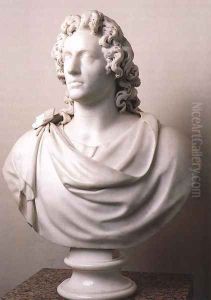Alexander Trippel Paintings
Alexander Trippel was a Swiss sculptor born on March 17, 1744, in Schaffhausen, Switzerland. He emerged as a prominent figure in the world of neoclassical sculpture, gaining recognition for his exceptional skill and artistic contributions during the 18th century. Trippel's journey in the arts began under the tutelage of his father, Johann Friedrich Trippel, who was also a sculptor. This early exposure to sculpting in his family's workshop laid the foundation for his lifelong passion and career in the arts.
Trippel's talent and ambition led him to further his studies abroad, notably in Paris and then in Rome, which was the epicenter of neoclassical art and thought during that period. In Rome, he became a student at the French Academy, where he was heavily influenced by the classical antiquities and the works of contemporaneous artists who were also drawn to the eternal city for its rich artistic heritage. It was in Rome that Trippel's style matured, characterized by his adherence to classical ideals, harmonious proportions, and a meticulous attention to detail, which distinguished his work from that of his peers.
Among Trippel's most celebrated works is the bust of German writer Johann Wolfgang von Goethe, created during Goethe's Italian journey in 1786-88. This bust captured Goethe's intellectual vigor and has been highly regarded for its lifelike representation and artistic merit. Additionally, Trippel is known for his contributions to the decoration of the Grand Ducal Palace in Weimar, further cementing his reputation in the annals of European art history.
Despite his success, Trippel's career was not without challenges. He navigated the complexities of patronage and the evolving tastes of the European art market, which, during his lifetime, began to shift towards Romanticism. Nevertheless, Trippel remained dedicated to the neoclassical style, contributing significantly to its development and leaving a lasting legacy through his teachings and works.
Alexander Trippel passed away on May 5, 1793, in Rome, Italy, leaving behind a body of work that continues to be admired for its classical beauty and technical excellence. His contributions to neoclassical sculpture have earned him a place among the notable artists of his time, and his works are studied and appreciated by art historians and enthusiasts to this day.
